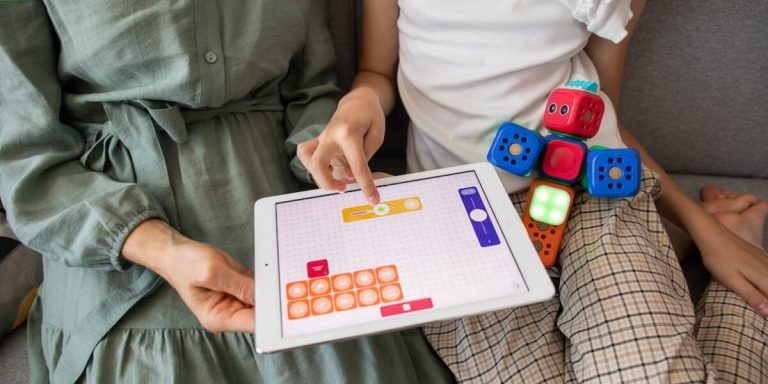What is Sensory Seeking: Understanding this Critical Childhood Behavior
Grappling with the question, “what is sensory seeking?” can often stir up concerns among parents and educators. Sensory seeking refers to a critical childhood behavior where children are instinctively drawn towards specific sensory experiences such as touch or movement. This deep-seated longing for specific forms of stimulation grows out of their inherent need to understand and navigate their surroundings.
This phenomenon plays an overarching role in child development, specifically impacting learning outcomes and social behaviors. Understanding this aspect equips us with essential knowledge required for developing successful special education resources and support strategies. By catering effectively to these unique needs, we usher in holistic growth while making learning more joyful and meaningful for every child embarking on his/her educational journey.
Did you know?
Did you know? Sensory seeking behavior is not exclusive to children with sensory processing disorder. In fact, all kids demonstrate some level of sensory-seeking actions during their early development as a part of exploring the world around them.
Understanding Sensory Seeking in Special Education
Sensory seeking, a term commonly used in the realm of special education, is induced when children display an increased craving for sensory stimulation. They usually engage in behaviors that allow them to satisfy their need for tactile experiences or visual and auditory cues. This can often be observed as unquenchable curiosity towards technology because it offers varied types of stimuli from lights and sounds to interactive screens which captivate these learners.
Special education is a resource-rich field that continues to evolve by:
- Incorporating assistive technological solutions to meet the unique needs of students like sensory-seekers.
- Designing tools for multi-sensorial experiences that stimulate engagement and understanding in these children.
- Providing healthy outlets for their natural desires for exploration and touch-based interaction.
These tools serve not only educational purposes but also therapeutic ones. They address students’ individual developmental challenges while simultaneously fostering academic progress.
Defining Sensory Seeking: Characteristics and Behaviors
Sensory seeking, a term frequently used in special education, refers to actions where an individual seeks out specific sensory experiences. The concept sits primarily around children with neurodevelopmental disorders such as autism spectrum disorder (ASD), attention deficit hyperactivity disorder (ADHD) and other related conditions.
To understand “what is sensory seeking”, we must first comprehend the basic idea of ‘senses’. We have five primary senses – sight, sound, touch, taste and smell – that help us perceive our world. However, some individuals may experience these differently or even seek certain sensations more than others due to varied neurological responses.
This fact brings us back again to the original question: what is sensory seeking?
Children who are labeled as “sensory seekers” exhibit an intense yearning for stimuli across one or multiple sense domains exceeding what’s considered conventional behavior among their peers.
No changes needed.
1. Constant movement – Sensory-seeking kids often find it hard sitting still; they fidget excessively and show high energy levels.
2. Love for loud noises- They might enjoy banging objects together louder than necessary or listening at higher volumes etc., being unfazed by unusually loud sounds.
3.Current obsession over textures- Infatuation with various textures can also signify this behavior—liking touching different surfaces repeatedly shows unusual interest toward tactile stimuli.
The Impact of Sensory Seeking on Learning Processes
What is sensory seeking? Undeniably, it’s a concept that needs unravelling. It refers to an intense craving for sensory stimuli and involves engaging in behaviors designed to meet this need.
Sensory-seeking kids are often seen as hyperactive or restless because they’re always moving, touching things, making noise.
In regards to learning processes, the impact of sensory seeking can’t be overstated. Let us delve further into our understanding of its effects on education especially within the realm of special education resources and support.
Firstly, children who display heightened levels of sensory seeking behavior often require different teaching strategies compared with their peers. They might need more hands-on activities or benefit from kinesthetic learning where they learn by doing rather than just seeing or hearing the material.
Secondly, classrooms must adapt physically too – providing tactile materials such as sand trays which can help channel these students’ energy productively while enabling them focus better on tasks at hand.
tailored lesson plans using multi-sensory techniques blending auditory and kinetic methods- facilitated through modern tech innovations- prove extremely beneficial in bridging comprehension gaps amongst such students.
Strategies for Supporting Sensory Seekers in the Classroom
In the modern classroom of 2023, grasping an understanding of sensory seeking is a milestone that every educator should strive to reach. Sensory seekers are children who display behaviors such as fidgeting and restlessness due to their brain’s demands for more stimulation. They will often look for ways to stimulate their senses through touching objects, moving around frequently or making noises.
Significant advancements in integrating technology into education support sensory seekers in school settings. Interactive whiteboards engage learners by involving multiple senses simultaneously, such as:
- Visual input from colorful images on the screen
- Auditory feedback from sounds associated with the visuals
Appropriate use of virtual reality (VR) offers immersive multisensory experiences that satisfy the high stimulation levels sensory-seeking learners need without disrupting the class.
Moreover, there’s a wealth of special education resources available online designed specifically with such unique needs in mind. These platforms offer activities like virtual tactile games that let students explore different textures using touch-screen devices; thereby creating a constructive outlet for their need to interact physically with things around them while facilitating cognitive development at the same time.
Educators must ensure they’re implementing strategies backed up by solid research where possible because not all digital resources might align well with individual student requirements – demonstrating both investment in quality teaching aids and empathetic understanding towards diverse learner profiles prevalent today.
Tailoring Educational Resources to Meet Sensory Needs
As an educator, understanding “what is sensory seeking?” can be crucial in tailoring educational resources to meet the sensory needs of children. Sensory-seeking behaviors are often observed among children with certain disorders such as Autism Spectrum disorder or ADHD. With access to special education resources and support, educators can foster a more conducive learning environment for these learners.
One strategy that has seen significant advances over recent years is the integration of technology into education – particularly within special needs classrooms. Technology assists not just academically but also aids students who struggle with managing their senses.
Reacting positively to specific color schemes on tablets or applications could calm down a student exhibiting signs of restlessness while auditory cues from digital apps might captivate those showing high levels of distraction. Using interactive software allows real-time changes enabling instructors to swiftly adjust lessons based on each child’s responses thereby providing individual attention even amidst group lessons.
A remarkable example would be tactile feedback devices offering ‘touch’ experiences by systematically releasing vibrations aligned with visual stimuli enhancing perception skills among visually impaired children.
Remember though; it’s essential to bring about this incorporation gradually avoiding an information overload leading your sensory seeker feeling overwhelmed which benefits no one involved.
Matching technologies according to each learner’s preference forms another key aspect when designing tech-integrated curriculums – some might find touchscreens convenient whereas others may respond better towards audio instructions or graphical illustrations helping wrap their head around abstract concepts like numbers and alphabets.
Developing a Multisensory Approach for Effective Teaching
Understanding what sensory seeking is forms the basis of developing an effective multisensory approach in teaching. It involves learners who exhibit a high desire for engaging their senses to gather information or respond to stimuli around them. These children are often drawn towards actions that stimulate balance, touch, movement and other sensations.
Incorporating technology can play a significant role in creating supportive environments for these students within classrooms. In the current year 2023, educators have access to various technological tools designed explicitly with special education resources and support strategies in mind.
Consider integrating interactive applications as part of your multisensory lesson plans. These apps not only engage multiple senses but also provide immediate feedback based on user interactions – perfect reinforcement tool especially beneficial for sensory seekers.
Similarly, consider using virtual reality (VR) technologies where possible.
Such experiences can safely expose students to different situations and environments — triggering various physical responses that make learning more impactful while still keeping control over potential overwhelming circumstances common among sensory-seekers.
Another useful resource could be utilizing audiobooks or speech-text software during lessons – it matches perfectly under visual and auditory stimulation strategies catering uniquely catered benefits such children require considering their inclination towards specific sense-directed stimulations..
Collaborative Efforts in Providing Special Education Support
Collaborative efforts have become the cornerstone in providing special education resources and support, especially when it comes to sensory seeking behaviors. Sensory-seeking children exhibit a strong desire for more intense sensory experiences like biting, excessive body movement or quest for vivid colors; their senses crave stimulation. In today’s era of technology-led teaching methodologies – being 2023 – educators and parents now harness these advancements to aid such students in an effective manner.
Today’s educational landscape embraces these needs with the integration of technology tailored specifically towards enhancing learning outcomes for all kids including those who are inclined towards specific stimuli. The use of interactive whiteboards, online tools that enable multisensory interactions as well as customized software help foster an environment conducive for engaging a child on his/her preferred mode – whether visual or tactile.
Moreover, collaboration among teachers, therapists (speech therapists occupational therapist etc.), parental involvement plays a major role not only in identifying but also managing sensory seeking behavior optimally- combining traditional classroom techniques with technologically advanced resources can make significant positive impacts on student progress.
Communication is made easier through digital channels between professionals giving advice concerning what measures should be taken at home and school alike which further strengthens this collective effort. It demonstrates how technological progression aids rather than impedes personal interaction within the sphere of childhood education thus contributing duly in supporting our young learners struggling with unique challenges due to their distinct sensorial perceptions.
Roles of Parents and Educators in Managing Sensory Seeking Traits
“Special Education, in the contemporary educational landscape of 2023, poses its unique challenges. One such challenge that continues to baffle parents and educators alike is managing children with sensory seeking traits. But what is ‘sensory seeking’?
It’s a term used to describe children who demonstrate an increased appetite for experiences leading them to seek out certain stimuli more often.
Understanding these behaviors can help primary caregivers and academic facilitators plan interventions effectively through technology integration in education. Here are ways parents and educators play crucial roles:
1) **Detecting Early Signs**: Parents usually observe their child’s patterns closely from infancy upwards – they’re best positioned to notice unusual tendencies early on.
2) **Seek Expert Consultation**: If your child demonstrates persistent sensory-seeking behavior beyond normal curiosity levels, it’s vital you consult a special education expert immediately.
3) **Advocate For Your Child** : As either parent or educator knowing about sensory issues helps advocate suitable learning environments ensuring minimal distractions & maximum comfort.
4) **Creating Suitable Learning Environment at Home/School:** Technology plays an important role here by providing tools like noise-cancelling headphones or weighted blankets; these items could prove beneficial for kids with heightened auditory & tactile sensation cravings respectively.
5)**Implement Tech-aided Therapies:** With rapid advancements in tech-integration methodologies within mainstream PEDAGOGY , implementation of VR (Virtual Reality), digital games promoting motor skills development fall under this purview.
Community Programs and Services Enhancing Special Education Resources
Special education represents a key cornerstone in the educational landscape. It’s an area that seeks to address varying learning needs not typically encountered in regular classrooms, including sensory seeking tendencies present among certain students. However, what is “sensory seeking”?
Sensory-seeking individuals are often motivated by particular sensations such as movement or touch and can occasionally find it challenging to engage through traditional teaching means.
In 2023 there has been breakthrough progress when discussing technology integration into special education. Community programs and services emerge, offering fresh perspectives on enhancing resources for these unique learners.
The first step towards this enhanced support system comes from developing digital platforms designed specifically with special ed students’ needs at heart – like intuitive interfaces that consider tactile engagement levels or algorithms incorporating various learning styles effectively catering to sensory seekers.
Also noteworthy is the increasing use of Artificial Intelligence (AI) powered applications which personalizes content delivery based on each student’s pace enabling better understanding absorption thus yielding improved outcomes overall–an advancement highly welcomed amidst growing calls for inclusivity diversity classroom environments nationwide!
Conclusion
As we draw upon the deep dive into “what is sensory seeking”, let’s remember that comprehending your child’s needs and behaviors are fundamental for their educational journey. As you trace this path of understanding, discovering these intricate details will help form stronger connections with them, aiding in more efficient learning experiences.
Don’t stop here! Our website offers a vast plethora of resources dedicated to enlighten parents and educators on various facets of childhood education. Whether it be navigating challenging behavior or implementing effective teaching strategies, our content covers all aspects holistically while providing steadfast support throughout your expedition as a parent or an educator.
Keep exploring for there’s always something new to learn every day when dealing with the tender minds and hearts!







